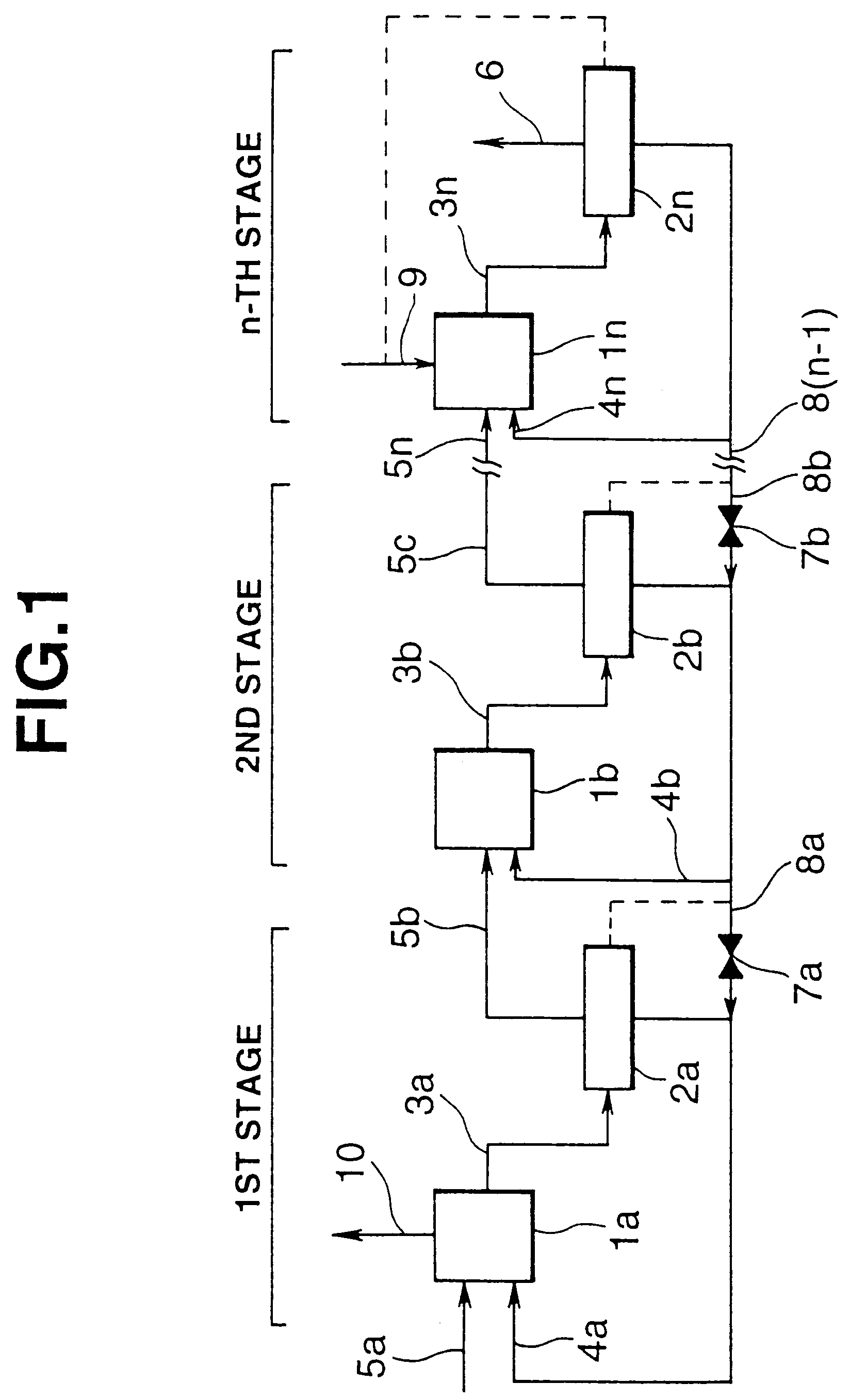Continuous hydrolysis of organochlorosilanes
a technology of organochlorosilane and continuous hydrolysis, which is applied in the direction of silicon organic compounds, organic chemistry, chemistry apparatus and processes, etc., can solve the problems of substantial drop of reactivity, increase of phase separation and transfer loads, and substantial loss of hydrogen chloride with wash liquid
- Summary
- Abstract
- Description
- Claims
- Application Information
AI Technical Summary
Benefits of technology
Problems solved by technology
Method used
Image
Examples
example 1
Hydrolysis in Three Stages
Hydrolysis reaction of dimethyldichlorosilane was carried out using the reaction system shown in FIG. 1 wherein the number of hydrolysis stages was 3.
Each stage includes a reactor of glass with an internal volume of 7 liters equipped with an agitator and a phase separator of glass with an internal volume of 8 liters. An overflow pipe was connected to the top of the phase separator. A discharge port is disposed at the bottom of the phase separator for circulating the aqueous hydrogen chloride solution to the reactor. The first stage reactor is provided with a feed port for feeding the reactant, dimethyldichlorosilane. The third stage reactor is provided with a feed port for feeding water. The phase separator of each reaction stage is equipped with a level gage for monitoring the level of solution therein.
In this reaction system, dimethyldichlorosilane was fed to the first stage reactor at a rate of 24 kg / hr to start reaction. After 2 hours, reaction became s...
example 2
Hydrolysis in Four Stages
Hydrolysis reaction of dimethyldichlorosilane was carried out using the reaction system shown in FIG. 1 wherein the number of hydrolysis stages was 4. Each stage included a reactor and a phase separator as in Example 1. The level of solution in the phase separator of each stage was monitored as in Example 1.
In this reaction system, dimethyldichlorosilane was fed at a rate of 24 kg / hr to the first stage reactor which was controlled to a pressure of 3.0 kgf / cm.sup.2 whereby hydrolysis reaction was started. After reaction became steady, the reaction temperature was maintained at 71.0.degree. C. in the first stage, 30.7.degree. C. in the second stage, 53.0.degree. C. in the third stage, and 68.5.degree. C. in the fourth stage. The aqueous hydrogen chloride solutions had a hydrogen chloride concentration of 39.8%, 24.4%, 3.0%, and 0.5% in the first, second, third, and fourth stages, respectively. The aqueous hydrogen chloride solution was independently circulated...
PUM
| Property | Measurement | Unit |
|---|---|---|
| Fraction | aaaaa | aaaaa |
| Fraction | aaaaa | aaaaa |
| Percent by mass | aaaaa | aaaaa |
Abstract
Description
Claims
Application Information
 Login to View More
Login to View More - R&D
- Intellectual Property
- Life Sciences
- Materials
- Tech Scout
- Unparalleled Data Quality
- Higher Quality Content
- 60% Fewer Hallucinations
Browse by: Latest US Patents, China's latest patents, Technical Efficacy Thesaurus, Application Domain, Technology Topic, Popular Technical Reports.
© 2025 PatSnap. All rights reserved.Legal|Privacy policy|Modern Slavery Act Transparency Statement|Sitemap|About US| Contact US: help@patsnap.com

